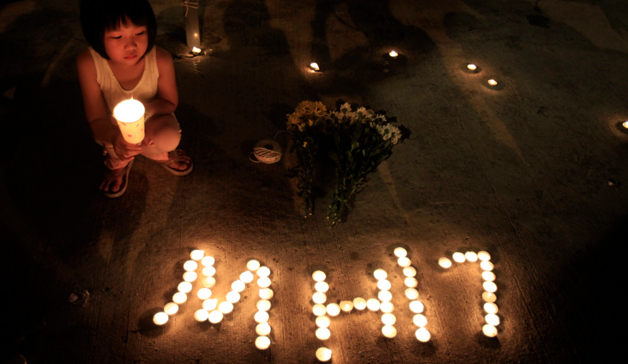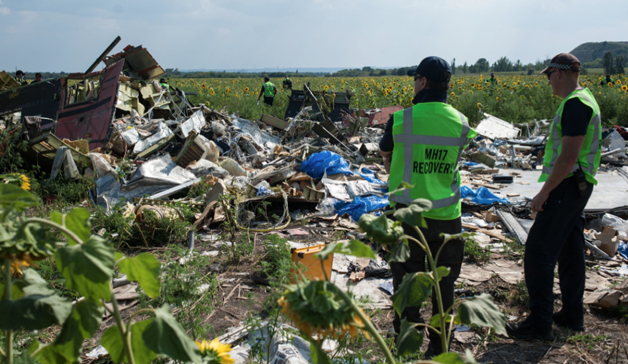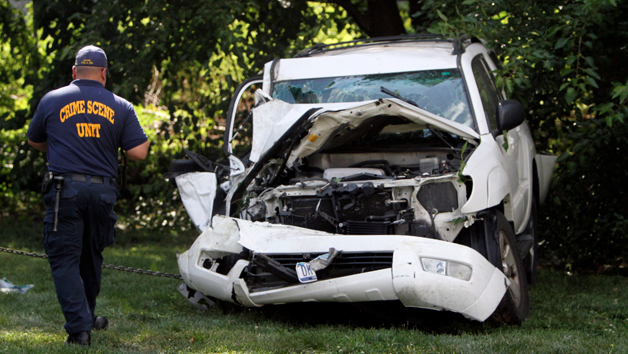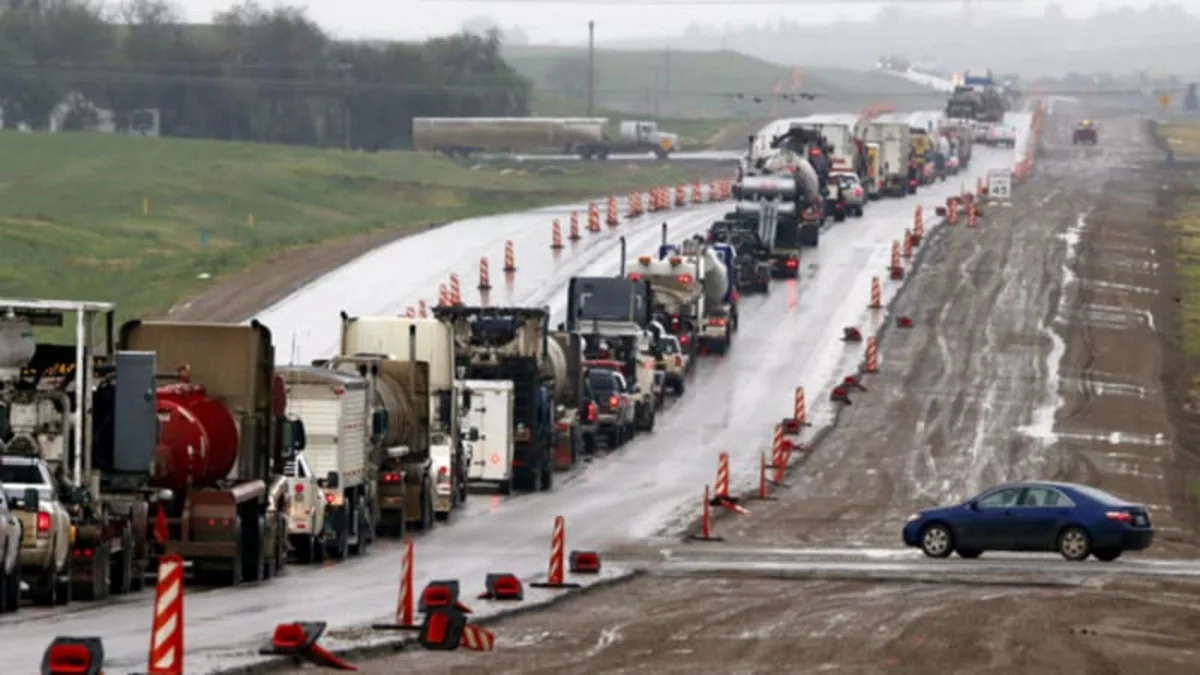It was a terrible stretch for aviation.
In an eight-day span last month, three commercial plane crashes killed 462 people. By now the flight numbers and grim circumstances are familiar: Malaysia Airlines flight 17, downed by a missile over the Ukraine. TransAsia 222, crashed on approach to an island off Taiwan. One day later, Air Algerie 5017, lost during a dust storm in Mali.
Over the same eight-day period that claimed hundreds in those high-profile air disasters, an estimated 735 people perished in traffic accidents in the United States alone. Across the globe, cars killed an estimated 28,493 over the same eight days and injured thousands more.
The air crashes brought the usual fear-of-flying tropes from the news media. Aside from the à-la-carte headlines in local news outlets, the traffic deaths generated their usual silence. Maybe it's time we pay more attention.
"Unless you're a skydiver or someone who feeds sharks, getting in a car is the single most dangerous thing you do," said Bruce Schneier, a security expert, policy analyst and essayist. "The same number of people who died in the 9/11 terrorist attacks die every month in car crashes, but it's just so normalized, we don't talk about it or think about it. But it's crazy how dangerous it is."
How dangerous? In the US, there were 33,561 traffic fatalities in 2012, the most recent year for which data is available, approximately 11.3 deaths per one billion vehicle miles traveled, according to the Fatality Analysis Reporting System. By comparison, only three people died in commercial aircrafts on American soil over the past three years. Air travelers die at a rate of 0.07 per billion passenger miles flown, according to a study from Northwestern University.
Air travel is far safer than driving in a car, but our perception of the comparative risks between driving and flying is skewed.
'A High-Dread Rating'
Human beings don't merely evaluate risk based on calculated odds, says David Ropeik, author of How Risky Is It: What Our Fears Don't Always Match The Facts. Instead, we filter risk through inherently subjective perspectives that are always running in our subconscious. So when it comes time to process the possibility of dying in a transportation-related accident, the mind sees a plane crash as a more lousy option.
"It's not the nature of dying, it's the nature of how you get dead," Ropeik said. "A plane crash is a particularly terrifying thing to imagine, dying that way. It has what we call a 'high-dread rating.' Basically, the more pain and suffering in the way you die, the more afraid of it you're going to be."
Catastrophic accidents that kill scores at once time tend to cause more dread than than accidents that are spread out over space and time. Sure, cars kill 1.3 million people worldwide every year, and the World Health Organization has called the traffic deaths a "global epidemic" on par with malaria and tuberculosis. But none of those are as emotionally dramatic as a plane crash.

The Risk-Perception Gap
These and other factors contribute to what Ropeik calls the "risk-perception gap." Early in our evolution, humans were pretty good at processing risks and surviving. Today, the risks are more complicated, and we worry more when we should be less concerned, and worry less when we should be more concerned. "Increasingly, risks call for more information and careful thought," he said. "But that's not the system we have."
In a report titled, Driving Fatalities After 9/11: The Hidden Cost Of Terrorism, researchers at Cornell University, after controlling for other factors, found the travelers' response to the attacks resulted in an additional 344 driving deaths per month in late 2001. While the effect of the attacks on transportation choices weakened over time, they attributed a total of 2,170 driving deaths to the attacks – a death toll that's about 70 percent of the approximate 3,000 Americans directly killed in the attacks themselves.
A similar study from the University of Michigan identified the same increase in traffic deaths, concluding there were nine percent more deaths than expected in the latter portion of 2001.
Individual choices are deadly enough; when our collective risk assessments are collected and used in larger-scale decision making, the consequences are magnified.

Politicians Treat Plane And Car Risks Differently
Our political response to risks and dangers in transportation are equally out of proportion. Consider this: The last major commercial plane crash in the US occurred more than five years ago. On February 12, 2009, Colgan Air flight 3407 experienced an aerodynamic stall in icing conditions near Buffalo, NY. Forty-nine people died.
The response from Washington was swift. The Federal Aviation Administration raised the flight time required to earn an airline transport pilot's license to 1,500 hours. In 2011, it imposed stricter duty and rest times on flight crews to combat pilot fatigue, which was cited as a factor in the accident.
When the National Transportation Safety Board proposed last year that the threshold for drunk driving, responsible for 25 percent of all traffic fatalities in 2012, be lowered to .05 blood-alcohol content, it was met with resistance.
Fatal trucking crashes have increased 18 percent on American roads since 2009, the same year as the Colgan crash. Yet the week after comedian Tracy Morgan's crash put the spotlight on tired truck drivers, Congress began debating a proposal that would allow truckers to drive 82 hours per week, a relaxation of current rules that cap drivers at 70 hours per week.
By its own estimates, the National Highway Traffic Safety Administration said roughly 200 Americans are killed every year – slightly less than half are children – when they are backed over. Even though Congress enacted a law that mandated better rear visibility way back in 2007 for almost all passenger vehicles, NHTSA didn't actually finalize the rules until earlier this year. They don't go into effect until 2018. In the lag, an estimated 2,200 more people will have been killed with little attention paid.
It'd be easy to blame the politicians who lack the will to protect Americans from automotive risks for these failings. But remember, they take their cues from the same Americans who, in a recent Harris Poll, acknowledged both drunk driving and texting-while-driving are dangerous – yet admitted to doing them anyway.

Here's Where It Gets Tricky
Cars kill an average of 91.9 people every day in the United States, and they're responsible for 94.4 percent of all transportation fatalities in America. By any measure, yes, driving is more dangerous than flying. But it can be easy to oversimplify that calculation. Hundreds of variables affect the assessment of risk.
A passenger flying from Cleveland to Houston has less risk than a passenger flying over a war zone. A passenger stopping to connect at a hub has a higher risk than a passenger who takes one transcontinental flight because accidents occur more often during takeoffs and landings. A person traveling in a private plane has a higher risk of dying than a person on a commercial flight.
And then there's time. All modes of transportation are safer today than they were a decade ago. Evaluating risk through the narrow snapshot of today might generate a different conclusion than one that considers historical risks involved with flying and driving.
"The numbers part of risk is a slippery business," Ropeik said. "You really have to be thoughtful as you think through your risks and your subpopulation denominator. In the end, even when you have that probability, you'll run those facts through a back filter to see how bad it might feel."
In the end, those emotions will win out. Fear of flying will continue to scare a certain segment of the population, when we'd all be a little better off at least pondering the more mundane, inherently riskier act of getting behind the wheel.
In an eight-day span last month, three commercial plane crashes killed 462 people. By now the flight numbers and grim circumstances are familiar: Malaysia Airlines flight 17, downed by a missile over the Ukraine. TransAsia 222, crashed on approach to an island off Taiwan. One day later, Air Algerie 5017, lost during a dust storm in Mali.
But it was a worse stretch for automobiles, and not that many noticed.In an eight-day span last month, three commercial plane crashes killed 462 people.
Over the same eight-day period that claimed hundreds in those high-profile air disasters, an estimated 735 people perished in traffic accidents in the United States alone. Across the globe, cars killed an estimated 28,493 over the same eight days and injured thousands more.
The air crashes brought the usual fear-of-flying tropes from the news media. Aside from the à-la-carte headlines in local news outlets, the traffic deaths generated their usual silence. Maybe it's time we pay more attention.
"Unless you're a skydiver or someone who feeds sharks, getting in a car is the single most dangerous thing you do," said Bruce Schneier, a security expert, policy analyst and essayist. "The same number of people who died in the 9/11 terrorist attacks die every month in car crashes, but it's just so normalized, we don't talk about it or think about it. But it's crazy how dangerous it is."
How dangerous? In the US, there were 33,561 traffic fatalities in 2012, the most recent year for which data is available, approximately 11.3 deaths per one billion vehicle miles traveled, according to the Fatality Analysis Reporting System. By comparison, only three people died in commercial aircrafts on American soil over the past three years. Air travelers die at a rate of 0.07 per billion passenger miles flown, according to a study from Northwestern University.
Air travel is far safer than driving in a car, but our perception of the comparative risks between driving and flying is skewed.
'A High-Dread Rating'
Human beings don't merely evaluate risk based on calculated odds, says David Ropeik, author of How Risky Is It: What Our Fears Don't Always Match The Facts. Instead, we filter risk through inherently subjective perspectives that are always running in our subconscious. So when it comes time to process the possibility of dying in a transportation-related accident, the mind sees a plane crash as a more lousy option.
"It's not the nature of dying, it's the nature of how you get dead," Ropeik said. "A plane crash is a particularly terrifying thing to imagine, dying that way. It has what we call a 'high-dread rating.' Basically, the more pain and suffering in the way you die, the more afraid of it you're going to be."
Catastrophic accidents that kill scores at once time tend to cause more dread than than accidents that are spread out over space and time. Sure, cars kill 1.3 million people worldwide every year, and the World Health Organization has called the traffic deaths a "global epidemic" on par with malaria and tuberculosis. But none of those are as emotionally dramatic as a plane crash.

The Risk-Perception Gap
These and other factors contribute to what Ropeik calls the "risk-perception gap." Early in our evolution, humans were pretty good at processing risks and surviving. Today, the risks are more complicated, and we worry more when we should be less concerned, and worry less when we should be more concerned. "Increasingly, risks call for more information and careful thought," he said. "But that's not the system we have."
This fundamental misinterpretation of risk can lead to unforeseen, tragic consequences. In the months following Sept. 11, for example, fears of flying surged. So many people eschewed the airlines in favor of driving that more died in car accidents. Researchers have documented a spike in traffic deaths they attribute directly to this phenomenon.This fundamental misinterpretation of risk can lead to unforeseen, tragic consequences.
In a report titled, Driving Fatalities After 9/11: The Hidden Cost Of Terrorism, researchers at Cornell University, after controlling for other factors, found the travelers' response to the attacks resulted in an additional 344 driving deaths per month in late 2001. While the effect of the attacks on transportation choices weakened over time, they attributed a total of 2,170 driving deaths to the attacks – a death toll that's about 70 percent of the approximate 3,000 Americans directly killed in the attacks themselves.
A similar study from the University of Michigan identified the same increase in traffic deaths, concluding there were nine percent more deaths than expected in the latter portion of 2001.
Individual choices are deadly enough; when our collective risk assessments are collected and used in larger-scale decision making, the consequences are magnified.

Politicians Treat Plane And Car Risks Differently
Our political response to risks and dangers in transportation are equally out of proportion. Consider this: The last major commercial plane crash in the US occurred more than five years ago. On February 12, 2009, Colgan Air flight 3407 experienced an aerodynamic stall in icing conditions near Buffalo, NY. Forty-nine people died.
The response from Washington was swift. The Federal Aviation Administration raised the flight time required to earn an airline transport pilot's license to 1,500 hours. In 2011, it imposed stricter duty and rest times on flight crews to combat pilot fatigue, which was cited as a factor in the accident.
If the 49 deaths in the Colgan Air crash merited attention from Washington, surely the 132,999 traffic deaths that have occurred in the intervening years have earned a proportional response? Not exactly.Cars kill an average of 91.9 people every day in the United States, and they're responsible for 94.4 percent of all transportation fatalities in America.
When the National Transportation Safety Board proposed last year that the threshold for drunk driving, responsible for 25 percent of all traffic fatalities in 2012, be lowered to .05 blood-alcohol content, it was met with resistance.
Fatal trucking crashes have increased 18 percent on American roads since 2009, the same year as the Colgan crash. Yet the week after comedian Tracy Morgan's crash put the spotlight on tired truck drivers, Congress began debating a proposal that would allow truckers to drive 82 hours per week, a relaxation of current rules that cap drivers at 70 hours per week.
By its own estimates, the National Highway Traffic Safety Administration said roughly 200 Americans are killed every year – slightly less than half are children – when they are backed over. Even though Congress enacted a law that mandated better rear visibility way back in 2007 for almost all passenger vehicles, NHTSA didn't actually finalize the rules until earlier this year. They don't go into effect until 2018. In the lag, an estimated 2,200 more people will have been killed with little attention paid.
It'd be easy to blame the politicians who lack the will to protect Americans from automotive risks for these failings. But remember, they take their cues from the same Americans who, in a recent Harris Poll, acknowledged both drunk driving and texting-while-driving are dangerous – yet admitted to doing them anyway.

Here's Where It Gets Tricky
Cars kill an average of 91.9 people every day in the United States, and they're responsible for 94.4 percent of all transportation fatalities in America. By any measure, yes, driving is more dangerous than flying. But it can be easy to oversimplify that calculation. Hundreds of variables affect the assessment of risk.
A passenger flying from Cleveland to Houston has less risk than a passenger flying over a war zone. A passenger stopping to connect at a hub has a higher risk than a passenger who takes one transcontinental flight because accidents occur more often during takeoffs and landings. A person traveling in a private plane has a higher risk of dying than a person on a commercial flight.
Risk in a car is equally complex. Urban roads are significantly safer than rural roads. Men die in traffic accidents at higher rates than women. Carrying passengers increases your chances of an accident. So does driving at night. If there is an accident, driving a smaller car increases the likelihood of injury or death. So does driving a car equipped with rudimentary safety technology."The numbers part of risk is a slippery business. You really have to be thoughtful as you think through your risks and subpopulation denominator." – David Ropeik
And then there's time. All modes of transportation are safer today than they were a decade ago. Evaluating risk through the narrow snapshot of today might generate a different conclusion than one that considers historical risks involved with flying and driving.
"The numbers part of risk is a slippery business," Ropeik said. "You really have to be thoughtful as you think through your risks and your subpopulation denominator. In the end, even when you have that probability, you'll run those facts through a back filter to see how bad it might feel."
In the end, those emotions will win out. Fear of flying will continue to scare a certain segment of the population, when we'd all be a little better off at least pondering the more mundane, inherently riskier act of getting behind the wheel.


Sign in to post
Please sign in to leave a comment.
Continue